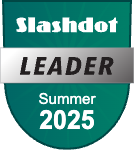This article is part of Beyond the Prompt — a campaign exploring Creativity and AI through the voices of industry leaders. Discover more stories, educational content, and our Shortest AI Film competition on the full campaign page.
Forward: You’re a photographer known especially for your legendary animal calendars and big campaigns for Moonboots, Adidas, and Helmut Lang — all shot with photo cameras. When did you first consider integrating AI into your workflow?
Daniel Gebhart de Koekkoek: I’ve always been curious about new technologies and would probably call myself an early adopter when it comes to digital art — I even got into NFTs back when they were having their moment. Every year, I release a calendar where I photograph animals in bizarre, sometimes absurd settings: there’ve been flying cats, swimming Afghans, and pin-up guinea pigs. For the 2025 edition, I decided to create all the images with AI. I basically fed it thousands of my own photographs, hoping to train it to generate images that felt like mine — snapshots with flash, a slightly trashy aesthetic, spontaneous moments. I wanted to avoid those hyper-clean, sci-fi AI aesthetics. And surprisingly, it worked. What I found most interesting were the glitches and weird mistakes AI made along the way — things I never would’ve come up with myself, and that actually sparked new ideas.
Forward: Where can AI be used effectively in photography — and where not?
Daniel Gebhart de Koekkoek: It’s incredibly helpful for commercial stuff: creating moodboards or quick visual concepts for clients. In advertising or product photography, where it’s about showing a thing, not capturing a feeling, it makes total sense. But when it comes to capturing those everyday authentic, emotional moments, AI still can’t compete, in my opinion.

Forward: In photography, there’s traditionally the decisive moment, the control over light, composition, and timing. What would you say is the ‘decisive moment’ in the AI process?
Daniel Gebhart de Koekkoek: For me, it’s those unexpected accidents — the errors and quirks AI throws out. Unlike photography, where you control everything, AI sometimes surprises you with unexpected results that can inspire new directions. So it’s less about control and more about exploring the unexpected.
Forward: As a photographer, copyright is obviously a big issue. With AI, these boundaries blur. How does AI change the concept of authorship for you? Is it still your work if parts of it are AI-generated?
Daniel Gebhart de Koekkoek: That’s exactly the dilemma. If I could tell an AI, “Only use my photos and nothing else,” I’d feel much better about it. That’s what I tried to do for the calendar — basically overwhelm it with my own material to steer it in my direction. But the truth is, you never really know what the AI is pulling from. And when you can’t trace what’s in the mix, it gets murky. That’s where authorship starts to get complicated.

Forward: With your collective Connected Archives, you pursue the idea of sustainable reuse of existing images and a fair approach to visual resources. How do you see AI’s role in this context, especially since it’s often trained on existing images without the creators’ consent?
Daniel Gebhart de Koekkoek: That’s one of the biggest issues we’re facing. Within our network of photographers, many have already discovered AI-generated versions of their images online without permission — and right now, there’s no real way to prove it or take action. What’s missing is transparency. If AI tools showed exactly which images were used in the process, like text tools now show their sources, it would be a huge step forward. Ideally, there’d also be a system where creators receive a share when their images contribute to AI-generated work. But honestly, at the moment, it feels like control is slipping away and no one’s seriously investing in fixing that.

Forward: How will you integrate AI into your work going forward? And how do you see AI and photography coexisting in the future?
Daniel Gebhart de Koekkoek: I love AI for everyday tasks. In terms of photography, I feel like I’m caught between two worlds. On one hand, I’m fascinated by AI and curious about what’s possible. On the other, it’s a big threat to our profession right now. In photography, I’m still waiting for that one clear, meaningful use case. I’m hopeful but still cautious. The truly human creativity and lived moments that photography captures can’t — and shouldn’t — be replaced by AI.
Learn more about Daniel Gebhart de Koekkoek here and on IG @doublekoek















.jpg)


.png)







